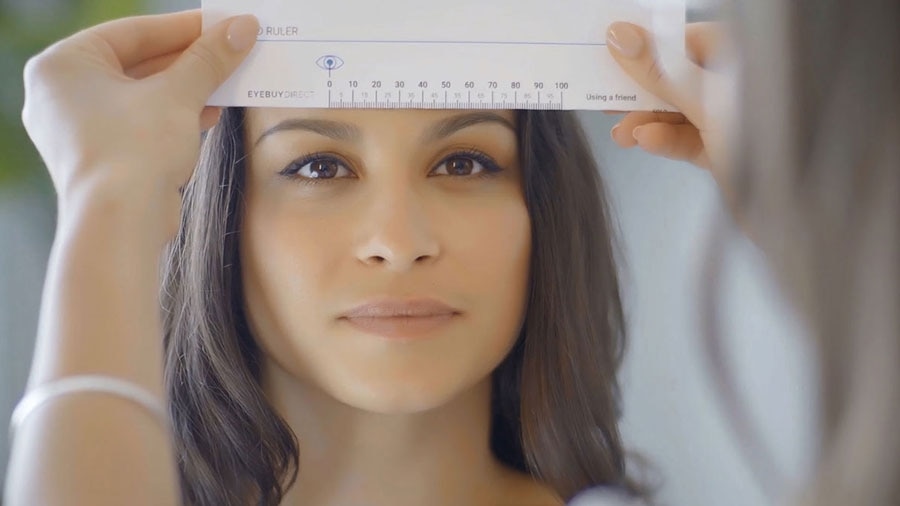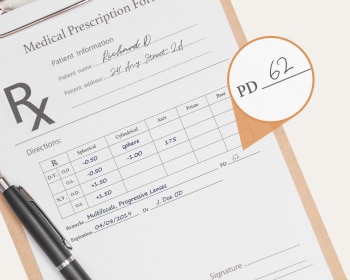How to Measure Pupillary Distance (PD)
You'll need to know your PD if you want to order new glasses online from Eyebuydirect. Don't worry if your glasses prescription doesn't include your PD, we can show you how to measure it by yourself at home. It’s easy to measure PD online — all you need is a mirror and our printable ruler, available to download below. You can also measure friends’ sizes and have them assist with telling you yours. If you’ve ordered prescription eyewear online with us before, you may have asked yourself, “what’s my PD and how do I measure it?” You can usually find your pupillary distance, also known as interpupillary distance, on your prescription, but if it’s missing, we can help!
What Is Pupillary Distance?
Pupillary distance, or PD, refers to the distance in millimeters between the center of one pupil to the center of the other. Having a correct PD on your vision prescription ensures that you’re looking through the ideal spot in your lenses.
If this number wasn’t provided on your prescription by an eye care professional, you can measure it yourself at home. Download and print our PD ruler, then follow the simple steps to measure your pupillary distance.
How to Measure PD
If you're using our PD ruler on someone else (or they're using it on you), fold it to the side that says “Using a friend.” Have them sit down and focus on something 10 to 20 feet ahead to keep their eyes steady.
Next, place the PD ruler against their forehead and align the zero with the center of their right pupil. The number above the center of their left pupil is their PD. When measuring, it may help to close one of your eyes so you can read the precise number.
How to Measure PD by Yourself
Measuring your pupillary distance is fairly simple, even if you're alone. All you need is our PD ruler and a mirror. Once you have what you need, follow the steps below:
Measure PD yourself
1
Fold the ruler, then flip it to the side that says “Using a mirror.”
2
Stand about 8 inches in front of a mirror. Hold the ruler horizontally over your eyes and center the zero directly over your left pupil. If needed, you can hold the ruler against your forehead for added stability.
3
Cover or close your left eye. The number directly over your right pupil is your pupillary distance.
How to read a prescription
You may want to relax, then remeasure a few times so you get the most accurate number. If you get different numbers each time, use the average as your final measurement. For example, if you measured your PD five times, add together all five of the numbers you got. Once you have that number, divide it by five. This will give you your final, or average, PD.
If you need progressive or bifocal lenses, you’ll also need to measure your near focus PD. You will need someone else to measure this for you to get the most accurate reading.
The person measuring should follow the same instructions as they would to get your regular PD. However, instead of focusing on an object 10 to 20 feet away, hold a pen between you and the measurer and focus on it. While you do this, the measurer can read and mark down your PD.
How Do I Find My PD for Glasses?
Your interpupillary distance is important for ensuring a particular point of the lenses goes directly over your pupils. This is especially true for people with high-powered lenses.
Your interpupillary distance may or may not be included on your vision prescription. However, it's normally listed as one number — 64 for example. If there’s a difference in measurement between the bridge of your nose and the center of each eye, your PD may also appear as two numbers — like 32 and 31. This is your PD separated for each eye.
What’s the Average PD for Women and Men?
The average PD for women and men falls somewhere between 48 mm and 73 mm. Women have an average of around 60 mm, while the average for men is about 64 mm. However, pupillary distance is different for everyone.
Single vs. Dual PD
Single pupillary distance is the measurement between the center of one pupil to the center of the other. Dual PD is the distance between the center of each pupil to the middle of the nose. The two numbers in a dual PD represent each of those distances, with the right eye’s PD appearing first.

WAYFARER
SKYLER


